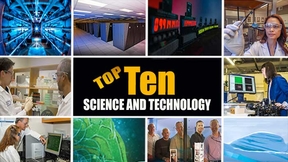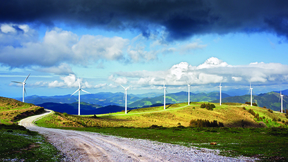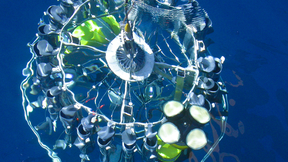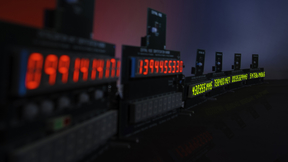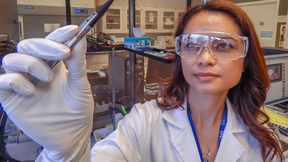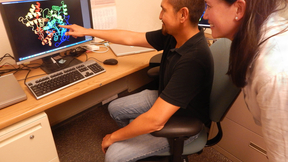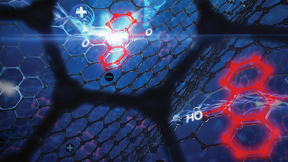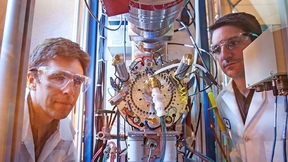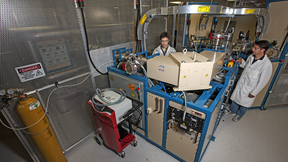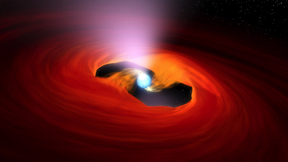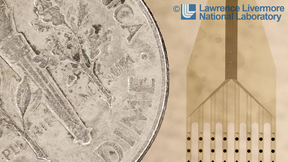Back
Physical and Life Sciences
Top 10 science and technology stories of 2014
In 2014, Lawrence Livermore National Laboratory (LLNL) built on a 62-year tradition of translating basic science into technologies that ensure national security, address pressing real world problems and expand the boundaries of fundamental science.The top stories of the year are a reflection of the Laboratory’s ability to apply its core national security competencies to a…
Cells build 'cupboards' to store metals
Lawrence Livermore researchers in conjunction with collaborators at University of California, Los Angeles have found that some cells build intracellular compartments that allow the cell to store metals and maintain equilibrium.Nearly 40 percent of all proteins require metal ions such as zinc, copper, manganese or iron for activity."We don't understand very well how cells…
X-ray laser acts as tool to track life's chemistry
An international research team that includes researchers from Lawrence Livermore National Laboratory has captured the highest-resolution protein snapshots ever taken with an X-ray laser, revealing how a key protein in a photosynthetic bacterium changes shape when hit by light.Human biology is a massive collection of chemical reactions and all involve proteins, known as the…
Webinar to present modeling and simulation capabilities critical for wind power industry
Learn more about Lawrence Livermore National Laboratory’s modeling and simulation capabilities critical for the wind power industry during the next monthly installment of the Industrial Partnerships Office (IPO) Technology & Market Discovery Webinar series, on Tuesday, Dec. 9.The presentation by Lab engineer and wind program leader Wayne Miller, titled "Toolkit for the…
Livermore Lab scientists show salinity matters when it comes to sea level changes
LIVERMORE, California -- Using ocean observations and a large suite of climate models, Lawrence Livermore National Laboratory scientists have found that long-term salinity changes have a stronger influence on regional sea level changes than previously thought. "By using long-term observed estimates of ocean salinity and temperature changes across the globe, and contrasting…
Lawrence Livermore scientist develops uncrackable code for nuclear weapons
Mark Hart, a scientist and engineer in Lawrence Livermore National Laboratory’s (LLNL) Defense Technologies Division, has been awarded the 2015 Surety Transformation Initiative (STI) Award from the National Nuclear Security Administration’s (NNSA) Enhanced Surety Program.The STI award aims to stimulate and encourage the development of potentially transformational nuclear…
Shifts in states of matter: It's complicated
The process of phase changes -- those transitions between states of matter -- is more complex than previously thought.A team of Lawrence Livermore researchers and colleagues has found that we may need to rethink one of science’s building blocks and illustrate how a proper theoretical description of transitions, so mundane and present in our daily life, has remained unclear…
Where did all the xenon go?
The noble gas xenon should be found in terrestrial and Martian atmospheres, but researchers have had a hard time finding it.The prevailing theory claims that due to xenon’s weight -- it is a heavy gas -- it could be trapped in a planet’s core or in the mantle during the planet’s formation. Lawrence Livermore scientists and collaborators have discovered that the xenon can…
Expert recognized for radiation detection work
Radoslav Radev received the International Electrotechnical Commission (IEC) "1906 Award" for his work on developing international standards for radiation detection instrumentation at an official ceremony held on Oct. 2 at the U.S. National Committee Council meeting in Washington, DC.Radev has served as an expert on the Nuclear Instrumentation Technical Committee and its…
Tiny carbon nanotube pores make big impact
A team led by the Lawrence Livermore scientists has created a new kind of ion channel consisting of short carbon nanotubes, which can be inserted into synthetic bilayers and live cell membranes to form tiny pores that transport water, protons, small ions and DNA.These carbon nanotube "porins" have significant implications for future health care and bioengineering…
Ask this scientist anything about neural research
Ever wonder what it's like to tap into the human brain? Or did you ponder about the best ways to understand neurological diseases and functions such as memory? Did you know tiny neural devices can potentially help patients see, hear and move?Vanessa Tolosa, an engineer at LLNL's Center for Bioengineering, will be answering those questions and more on the popular social…
Supercomputers link proteins to drug side effects
LIVERMORE, California - New medications created by pharmaceutical companies have helped millions of Americans alleviate pain and suffering from their medical conditions. However, the drug creation process often misses many side effects that kill at least 100,000 patients a year, according to the journal Nature. Lawrence Livermore National Laboratory researchers have…
Energy storage of the future
Personal electronics such as cell phones and laptops could get a boost from some of the lightest materials in the world.Lawrence Livermore researchers have turned to graphene aerogel for enhanced electrical energy storage that eventually could be used to smooth out power fluctuations in the energy grid.The team found that graphene aerogel-based supercapacitor electrodes…
Lab, UC Davis partner to personalize cancer medications
Buoyed by several dramatic advances, Lawrence Livermore National Laboratory scientists think they can tackle biological science in a way that couldn't be done before.Over the past two years, Lab researchers have expedited accelerator mass spectrometer sample preparation and analysis time from days to minutes and moved a complex scientific process requiring accelerator…
Biological sample prep time cut dramatically -- from days to minutes
When Lawrence Livermore National Laboratory researchers invented the field of biological accelerator mass spectrometry (AMS) in the late 1980s, the process of preparing the samples was time-consuming and cumbersome. Physicists and biomedical researchers used torches, vacuum lines, special chemistries and high degrees of skill to convert biological samples into graphite…
Randles receives National Institutes of Health award to pursue cancer research
Lawrence Livermore National Laboratory computational scientist Amanda Randles has received a Director's Early Independence Award from the National Institutes of Health (NIH).The NIH Common Fund award provides funding to encourage exceptional young scientists to pursue "high risk, high reward" independent research in biomedical and behavioral science. Randles will receive…
Dead star shines on
A supernova is the cataclysmic death of a star, but it seems its remnants shine on.Astronomers have found a pulsating, dead star beaming with the energy of about 10 million suns.This is the brightest pulsar -- a dense stellar remnant leftover from a supernova -- ever recorded, and was seen using NASA's Nuclear Spectroscopic Telescope Array, or NuSTAR.LawrenceLivermore LLNL…
Livermore scientists suggest ocean warming in Southern Hemisphere underestimated
LIVERMORE, California -- Using satellite observations and a large suite of climate models, Lawrence Livermore scientists have found that long-term ocean warming in the upper 700 meters of Southern Hemisphere oceans has likely been underestimated."This underestimation is a result of poor sampling prior to the last decade and limitations of the analysis methods that…
Identifying the many layers of a bug's design
Lawrence Livermore researchers have discovered additional "coats," or layers, of a bacterium spore found in the human gut that may give clues to how this organism develops, spreads and survives in extreme conditions.The team dove into the spore coats of the bacterium Bacillus subtilis, which also is known as hay bacillus or grass bacillus. Scientists found that in addition…
NIH taps Lab to develop sophisticated electrode array system to monitor brain activity
LIVERMORE, Calif. - The National Institutes of Health (NIH) awarded Lawrence Livermore National Laboratory (LLNL) a grant today to develop an electrode array system that will enable researchers to better understand how the brain works through unprecedented resolution and scale.LLNL's grant-funded project is part of NIH's efforts to support President Obama's BRAIN (Brain…


